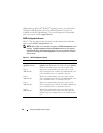
Using the System Setup Program 47
Memory Information Screen
Table 2-3 lists the descriptions for the information fields that appear on the
Memory Information screen.
Serial Communication Displays a screen to configure serial communication,
external serial connector, fail-safe baud rate, remote
terminal type, and redirection after boot.
Embedded Server
Management
Displays a screen to configure the front-panel LCD options
and to set a user-defined LCD string.
System Security Displays a screen to configure the system password and
setup password features (see Table 2-8). For further
information, see "Using the System Password" on page 56
and "Using the Setup Password" on page 59.
Keyboard NumLock
(On default)
Determines whether your system starts up with the
NumLock mode activated on 101- or 102-key keyboards
(does not apply to 84-key keyboards).
Report Keyboard Errors
(Report default)
Enables or disables reporting of keyboard errors during the
POST. Select Report for host systems that have keyboards
attached. Select Do Not Report to suppress all error
messages relating to the keyboard or keyboard controller
during POST. This setting does not affect the operation of
the keyboard itself if a keyboard is attached to the system.
Table 2-3. Memory Information Screen
Option Description
System Memory Size Displays the amount of system memory.
System Memory Type Displays the type of system memory.
System Memory Speed Displays the system memory speed.
Video Memory Displays the amount of video memory.
System Memory Testing Specifies whether system memory tests are run at system
boot. Options are Enabled and Disabled.
Table 2-2. System Setup Program Options (continued)
Option Description


















